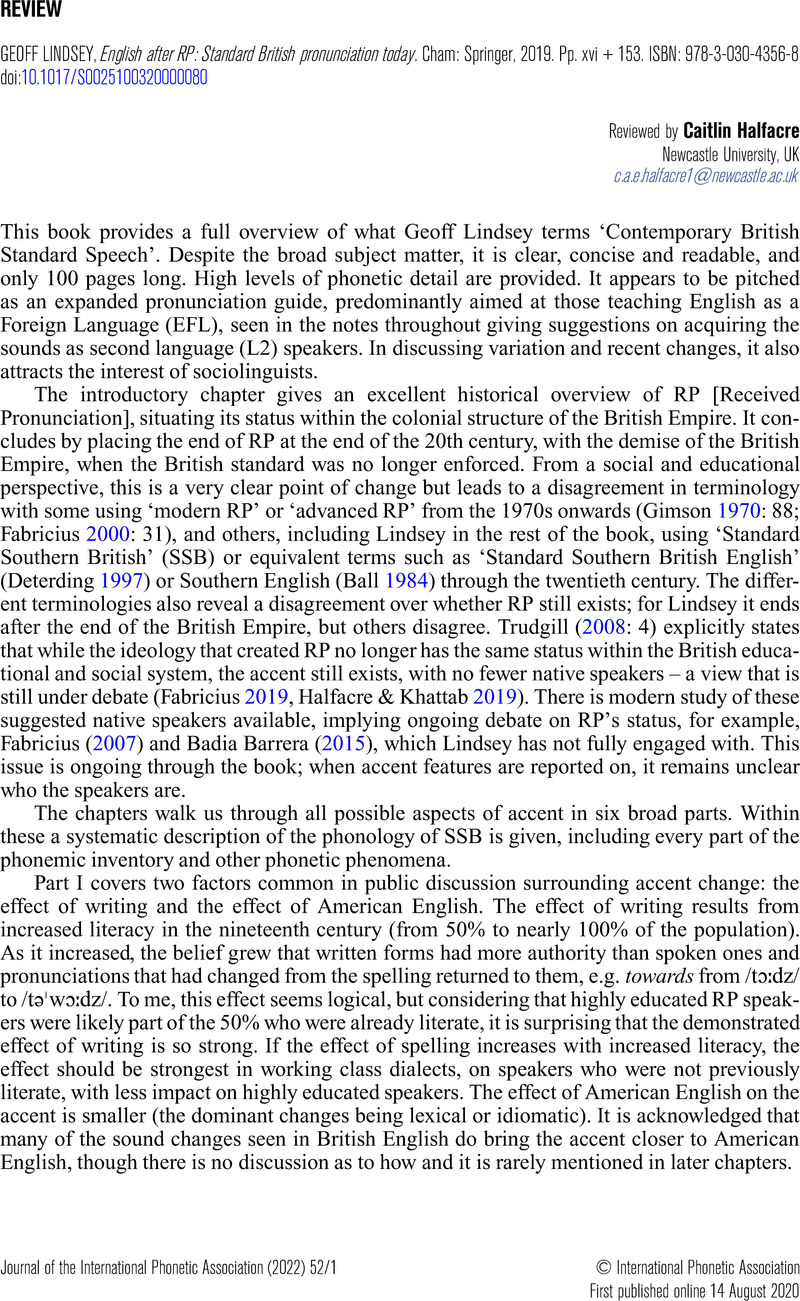No CrossRef data available.
Article contents
GEOFF LINDSEY, English after RP: Standard British pronunciation today. Cham: Springer, 2019. Pp. xvi + 153. ISBN: 978-3-030-4356-8
Review products
GEOFF LINDSEY, English after RP: Standard British pronunciation today. Cham: Springer, 2019. Pp. xvi + 153. ISBN: 978-3-030-4356-8
Published online by Cambridge University Press: 14 August 2020
Abstract
An abstract is not available for this content so a preview has been provided. Please use the Get access link above for information on how to access this content.

- Type
- Book Review
- Information
- Journal of the International Phonetic Association , Volume 52 , Issue 1 , April 2022 , pp. 189 - 193
- Copyright
- © International Phonetic Association 2020
References
Ball, Martin J. 1984. The centring diphthongs in Southern English: A sound change in progress. Journal of the International Phonetic Association 14, 38–44.CrossRefGoogle Scholar
Barrera Badia, Berta. 2015. A sociolinguistic study of T-glottalling in young RP: Accent, class and education. Ph.D. dissertation, University of Essex.Google Scholar
Deterding, David. 1997. The formants of monophthong vowels in Standard Southern British English pronunciation. Journal of the International Phonetic Association
27, 47–55.CrossRefGoogle Scholar
Fabricius, Anne H.
2000. T-glottalling between stigma and prestige: A sociolinguistic study of modern RP. Ph.D. dissertation, Roskilde University.Google Scholar
Fabricius, Anne H.
2002. Ongoing change in modern RP: Evidence for the disappearing stigma of t-glottalling. English World-Wide 23(1), 115–136.CrossRefGoogle Scholar
Fabricius, Anne H.
2007. Variation and change in the trap and strut vowels of RP: A real time comparison of five acoustic data sets. Journal of the International Phonetic Association 37(3), 293–320.CrossRefGoogle Scholar
Fabricius, Anne H.
2019. The anticlockwise checked vowel chain shift in modern RP in the twentieth century: Incrementations and diagonal shifts. In Calhoun, Sasha, Escudero, Paola, Tabain, Marija & Warren, Paul (eds.), 19th International Congress of Phonetic Sciences (ICPhS XIX), Melbourne, 592–596.Google Scholar
Gimson, A. C.
1970. An introduction to the pronunciation of English, 2nd edn. London: Edward Arnold.Google Scholar
Halfacre, Caitlin & Khattab, Ghada. 2019. North–South dividers in privately educated speakers: A sociolinguistic study of Received Pronunciation using the foot–strut and trap–bath distinctions in the North East and South East of England. In Calhoun, Sasha, Escudero, Paola, Tabain, Marija & Warren, Paul (eds.), 19th International Congress of Phonetic Sciences (ICPhS XVIII), Melbourne, 2665–2669.Google Scholar
Jenkins, Jennifer. 2006. Current perspectives on teaching world Englishes and English as a lingua franca. TESOL Quarterly
40(1) 157–181.CrossRefGoogle Scholar
O’Connor, J. D. & Arnold, G. F.. 1973. Intonation of colloquial English, 2nd edn. London: Longman.Google Scholar
Trudgill, Peter. 2008. The historical sociolinguistics of elite accent change: On why RP is not disappearing. Studia Anglica Posnaniensia
44, 3–12.Google Scholar
Warren, Paul. 2016. Uptalk: The phenomenon of rising intonation. Cambridge: Cambridge University Press.CrossRefGoogle Scholar
Wells, J. C.
1982a. Accents of English 1: An introduction. Cambridge: Cambridge University Press.CrossRefGoogle Scholar
Wells, J. C.
1982b. Accents of English 2: The British Isles. Cambridge: Cambridge University Press.CrossRefGoogle Scholar
Yuasa, Ikuko Patricia.
2010. Creaky voice: A new feminine voice quality for young urban-oriented upwardly mobile American women?
American Speech
85(3), 315–337.CrossRefGoogle Scholar





